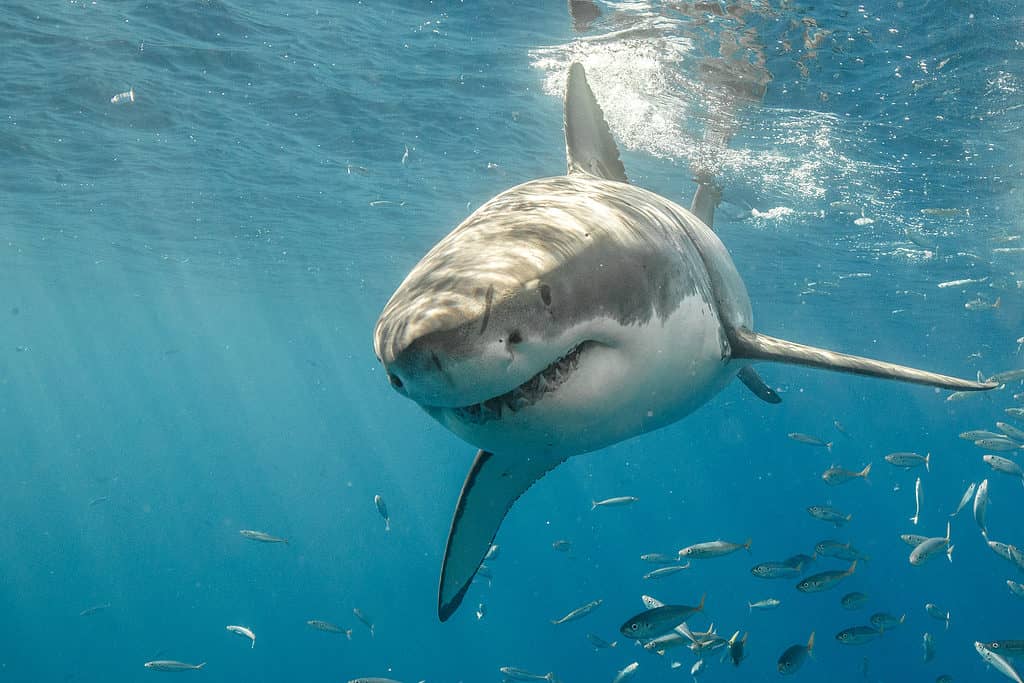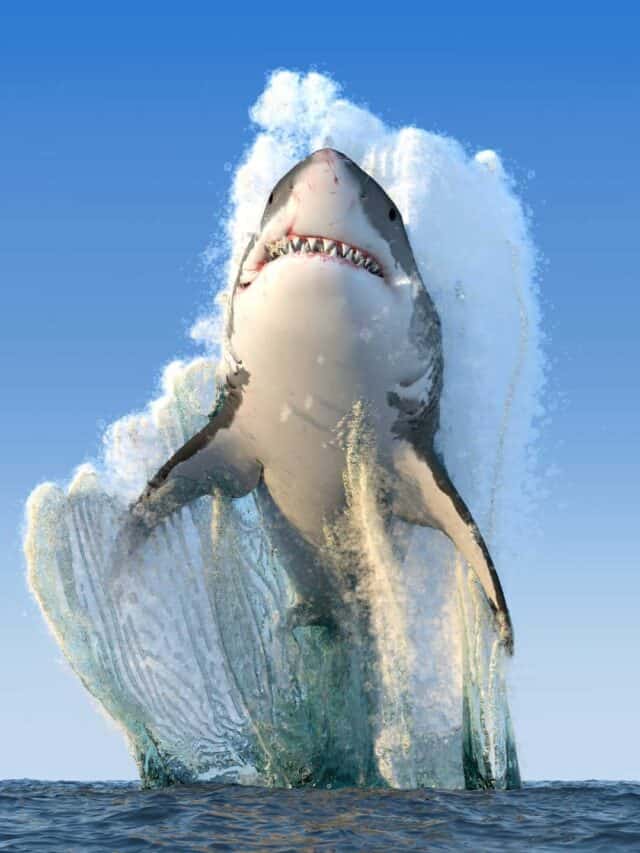Fishing always has an element of mystery to it. Once you toss your line in the water, you really don’t know what could be lurking beneath the surface! In most freshwater environments, river monsters are the worst things you can encounter, but in the ocean, who knows what sorts of things you could accidentally hook? In a recently uploaded TikTok, we see just how crazy the ocean’s creatures can be and also get a bit of insight into a practice that is harming sea life.
Click The Link To Check Out The Short Video Clip Below
In the TikTok clip, a massive creature has accidentally been caught by a commercial fishing vessel. Lying atop a pile of small silverfish is a HUGE shark. For anyone who’s watched Shark Week before, it’s pretty easy to tell what kind of shark it is—a great white!
Somehow, a great white shark ended up stuck on the deck of a commercial fishing vessel. Generally, great whites are pretty rare, so seeing one out of the water and on the deck of your ship is pretty surprising! Thankfully, we are able to witness along with the fisherman as someone decided to film it.

A
great white shark
somehow ended up stuck on the deck of a commercial fishing vessel.
©iStock.com/
Although the clip is only 5 seconds long, we can see that the fishermen have attached some sort of pulley system to their machinery and started to lift the shark clear of the boat. Despite heading out on the boat to catch fish, a great white isn’t the kind of fish that they were hoping to snag!
Since the shark was so heavy and potentially dangerous, the fishermen decided it was best to let a machine do all the work. Large sharks can grow up to 5,000 lbs and can be as long as 16 feet! As the video ends, we see the shark being lifted, hopefully, to be released back into the water that it came from. Funny enough, it seems to grab a fish as a to-go snack on its way out!

Large sharks can grow up to 5,000 lbs and can be as long as 16 feet.
©Jsegalexplore/Shutterstock.com
Is This Normal?
After watching the clip, it’s easy to be confused as to how a great white ended up on the deck of a boat anyway. Sadly, this probably occurs all too often. When large commercial vessels go out to fish, they sweep their nets across large swaths of the ocean in a process known as trawling. After traveling some distance, they will then pull in the nets and dump the contents onto the deck for sorting. As one might imagine, it’s hard to control the type of fish that a trawler gets. These unintentionally caught fish are known as “bycatch.”
Bycatch is one of the leading causes of species extinction across the globe. In fact. Oceana.org states:
BYCATCH, OR THE CATCH OF NON-TARGET FISH AND OCEAN WILDLIFE, IS ONE OF THE LARGEST THREATS TO MAINTAINING HEALTHY FISH POPULATIONS AND MARINE ECOSYSTEMS AROUND THE WORLD. According to some estimates, global bycatch may amount to 40 percent of the world’s catch, totaling 63 billion pounds per year.
Oceana
Where Do Great White Sharks Live?
Great white sharks can be found in almost all coastal waters with temperatures between 50 and 80 degrees Fahrenheit. They are most commonly found near North America, South Africa, Japan, Australia, and New Zealand. Great whites tend to prefer cooler waters, but they have been spotted as far north as the Arctic Circle and as far south as Chile. Some great white populations also inhabit temperate rivers such as the San Francisco Bay in California and the River Thames in England. The deep ocean is another place that great whites inhabit. They dive hundreds of feet below sea level, searching for food or migrating to warmer climates during winter months.

Great white sharks can live for up to 70 years.
©iStock.com/ShaneMyersPhoto
Lifespan
The lifespan of great white sharks is not yet fully understood, but estimates suggest they can live up to 70 years in the wild. With proper care and protection, some have been known to live even longer in captivity. Depending on their environment, diet, and other factors like predation and disease, their lifespans may vary.
Great whites reach sexual maturity between 10–14 years old when they are approximately 9 feet long. They continue to grow until they reach an average adult size of 13-16 feet. It is believed that older mature individuals may be able to increase their body sizes even further due to a phenomenon called “hyperplasia.”

A massive great white shark leaps into the air in a grand display.
©Alexyz3d/Shutterstock.com
Conservation Status
The current conservation status of great white sharks is vulnerable, according to the International Union for Conservation of Nature’s (IUCN) Red List. This means that they are facing a high risk of extinction in the near future. The main threats to their survival are overfishing, bycatch, and habitat loss due to coastal development and ocean pollution. In addition, their numbers have been reduced due to illegal hunting for sport or commercial gain.
To address this issue and conserve these majestic creatures, efforts have been made on an international level, such as introducing protection measures within certain areas, implementing responsible fishing practices, reducing marine debris and plastic pollution levels in oceans, and creating safe havens where populations can thrive without pressure from human activity.

Great white sharks are vulnerable to extinction.
©Digital Storm/Shutterstock.com
Great White Shark vs. Tiger Shark
A great white shark and a tiger shark are both powerful predators that roam the oceans. However, they have some key differences. The most obvious difference between them is their size. Great white sharks can grow up to 20 feet in length, while tiger sharks only reach 12-14 feet. Great whites also have a distinctive look, with a gray upper body and white belly. Tiger sharks have dark stripes down their sides which lighten as they age, giving them an almost checkered appearance.
In terms of behavior, great whites tend to be more aggressive towards other species than tiger sharks are, although neither species is particularly sociable! Both types of sharks feed on fish and marine mammals like seals or dolphins, but the hunting style used by each differs significantly. Great whites use quick bursts of speed to catch their prey, whereas tiger sharks rely on stealthy maneuvers such as ambushing from below or stalking schools of smaller fish for long periods before striking.
How Large Do Great White Sharks Get?

Great white sharks are the largest predatory fish in the world.
©Alexius Sutandio/Shutterstock.com
The size of a great white shark is notable, as it’s the largest predatory fish in the world. The great white is a type of mackerel shark, with males growing from 11-13 feet long on average, while females reach lengths of 15-16 feet long. The largest male on record, Randall from Ledge Point Western Australia, measured 19.7 feet long. A female shark captured by David Mckendrick near Prince Edward Island in Canada measured 20 feet long.
Great white sharks usually weigh from 1,500 to 2,400 pounds. The biggest preserved great white shark, a female, weighs a massive 4,410 pounds while measuring 19.1 feet in length. It’s obvious that great white sharks are undeniably huge ocean animals!
The photo featured at the top of this post is © Martin Prochazkacz/Shutterstock.com
Thank you for reading! Have some feedback for us? Contact the AZ Animals editorial team.






